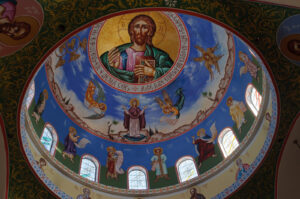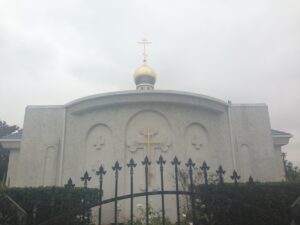In this tip sheet, you will discover foundational information to help you interact with Orthodox Christian leaders. It is part of a set of tools and training for FEMA to help disaster response professionals engage with faith communities. Much of the information also can help students, researchers, government agencies, non-profits and businesses learn about and develop relationships with communities. Click here for the PDF version of this tip sheet.
Religion Called: Orthodox Christianity
Adherents Consider Themselves: Christian and are called Orthodox Christians
House of Worship: Church or Cathedral
First Point of Contact: Senior parish priest a.k.a. pastor
Religious Leader: Priest or Deacon
Spoken Direct Address: Use “Father”
Physical Interaction: Handshake O.K. across genders
HOUSE OF WORSHIP
- Churches are local houses of worship. A parish refers to the congregation of a particular church.
- Parishes often have non-sacred spaces such as multipurpose rooms, schools, gyms, or offices.
- Cathedrals are large centers of worship for an entire regional area run by a Diocese or Archdiocese.
- Monasteries and convents house monks and nuns (respectively), and may include a chapel and areas for instruction/work.
RELIGIOUS LEADERS
Ordained/Commissioned/Licensed Leaders
- Orthodox Christian leadership is hierarchical with each national/ethnic branch having its own structure and leadership.
- Regional leadership generally falls to bishops (or archbishops, catholicos, or metropolitans).
- Priests and deacons provide sacramental and spiritual leadership; priests often are in charge of a local parish.
- Both priests and deacons are permitted to marry.
Holy Orders and Lay Leaders
- Monks and nuns are non-ordained (lay) leaders (except for hiermonks who are ordained priests or deacons) who have usually taken a vow of poverty, celibacy, and obedience and often live an active vocation of both prayer and service. Many monks, nuns, and laypersons have important leadership positions —avoid assumptions based on title.
- Some U.S. parishes have lay administrators who take on many of the roles once the exclusive domain of clergy.
POINTS OF CONTACT
- Local: Parish, led by a priest and staff. Oversight may fall entirely to the pastor and his staff; or in many cases a pastor will consult with an elected parish council of lay community members. First point of contact should be with the senior parish priest who has ultimate authority over parish resources.
- Regional: Diocese/Archdiocese, led by a bishop, archbishop or metropolitan.
- National: For the Orthodox Church in America, the Metropolitan. For Greek Orthodox Archdiocese of America, the Archbishop (Other Orthodox churches have their own U.S. heads consisting of an archbishop, metropolitan, or bishop).
NVOAD MEMBERSHIP AND CORE CAPABILITIES IN DISASTER
National Voluntary Organizations Active in Disaster (NVOAD) is a nonprofit, nonpartisan, membership based organization that serves as the forum where organizations share knowledge and resources throughout the disaster cycle. FEMA DSA team members should check with their VAL to determine whether local or regional VOADs exist in their operational area. National VOAD members include:
- International Orthodox Christian Charities (IOCC)
ETIQUETTE QUICK TIPS
Greeting
When introducing yourself to a religious leader, use formal religious titles unless instructed otherwise. Deacons and Priests: Father. Bishops: Your Grace. Archbishops/Metropolitans: Your Eminence (Your Beatitude for heads of independent Churches, and Your Excellency for Titular Metropolitans).
Physical Interaction
Many Orthodox Christians exchange a “kiss of peace” when greeting those of the same or opposite gender (not expected of non-Orthodox). In Greek and Arab churches a kiss on both cheeks is customary. In Russian churches there are three kisses.
Other
When entering an Orthodox Christian church, cathedral, or other sacred space, shoes are generally left on but men should remove hats or caps. These spaces are considered sacred 24 hours a day – not only when they are being used. Responders should treat sacred spaces with respect and deference and refrain from certain behaviors such as eating, drinking, talking loudly, touching objects, or entering certain areas without permission. Visitors should wear conservative clothing covering the shoulders and knees. Stand when a priest enters the room and remove hats or caps. Ask before participating in worship services and do not take communion unless you are Orthodox Christian. Ushers can help with customs, dress, and etiquette.
GOVERNANCE / JUDICATORY
“Orthodox Christianity” includes the Eastern Orthodox Church and Oriental Orthodoxy. In general, governance is hierarchical and Archdioceses, Metropolises, Dioceses are administrative districts led by a bishop who oversees the jurisdiction’s churches.
- The Eastern Orthodox Church is composed of 15 autocephalous (administratively independent) branches (each organized primarily along ethnic or national lines) that share the same beliefs, sacraments, and canonical discipline. Each has its own structure, titles, and maintains the right to elect its head (Catholicos or Patriarch) and its bishops.
- There are also churches using “Orthodox” in their name but not in communion with the 15 autocephalous churches, as well as Eastern Catholic Churches with Orthodox roots and practices but in communion with the Holy See in Rome.
- The ecumenical patriarch of Constantinople (Istanbul) is the international head of Eastern Orthodoxy (while also overseeing the Greek Archdiocese of America and certain other Orthodox churches); recognized as the “first among equal” Orthodox bishops. Most Eastern Orthodox Christians acknowledge his spiritual leadership.
- The Orthodox Church in America (OCA) is governed by the Holy Synod of Bishops (all diocesan bishops). The head of the synod is the Metropolitan of All-America and Canada.
- The Oriental Orthodox communion is distinct from the Eastern Orthodox Church and is composed of six churches: Coptic, Ethiopian, Eritrean, Syriac, Malankara Syrian (Indian Orthodox Church), and the Armenian Apostolic churches.
MEETING LOGISTICS AND SCHEDULING
Scheduling and Holidays
Orthodox Christian churches observe the Lord’s Day (Sunday) with the Divine Liturgy (similar to the Roman Catholic Mass). While all Orthodox Christians celebrate Pascha at the same time, some use the Old Julian calendar (currently 13 days behind).
- The Nativity of Christ (Christmas), Dec 25 (New Calendar), Jan 7 (Old Cal): celebration of birth of Jesus as God Incarnate.
- Epiphany, Jan 6 (New Calendar), Jan 19 (Old Cal): time of blessing of homes with holy water to recall Jesus’ baptism.
- The entry of Jesus into Jerusalem (Palm Sunday): one week before Pascha.
- Great and Holy Friday: commemoration of the death of Christ on the Cross, beginning with worship on Thursday evening and concluding with Vespers on Friday afternoon.
- Pascha (Easter): ritual preceded by a vigil on Sat. evening through Sun. dawn which celebrates the resurrection of Jesus.
- Pentecost: commemorates receipt of the Holy Spirit by the nascent Christian community 50 days after Jesus’ resurrection.
Food
Many Orthodox Christians fast on Wednesdays and Fridays, plus four extended periods:
- Great Lent (the seven weeks before Pascha).
- Nativity Fast (40 days, November 15th through December 24th).
- Fast of the Apostles (from the Monday eight days after Pentecost until June 28th —the Feast of Saints Peter and Paul).
- Dormition Fast (August 1st-14th, in honor of death of the Virgin Mary).
- Fasting involves abstinence from red meat, poultry, meat products, eggs, dairy products, fish, oil, and wine—with provision for eating some of these items on certain days during the long fasting periods. December 24th is a strict fast.
Logistics
The senior priest/Pastor of a parish has ultimate authority within the parish on spiritual, financial, and administrative decisions. They may be assisted by a business manager or parish associate who oversees the day-to-day operation of the parish and answers to the Pastor. It is important to foster a relationship and buy-in with the manager, as they often know the inner workings of the parish even if they do not hold the title of authority and power.
DRESS
Orthodox Christian dress is usually a combination of culture and ethnicity, not religious requirement. While head covering at worship for women is the norm in Orthodox Christianity, it is often dispensed within U.S. parishes. Clergy, monks, and nuns usually wear identifying garb. For clergy: a traditional long black robe (cassock) or a black suit with a black shirt and white circular collar. For monks and nuns: a habit. Clergy don ceremonial clothing when conducting services. Male leaders often wear beards. Clergy sometimes appear in secular settings in street clothes.
ABOUT CHRISTIANITY: ORTHODOX
“Orthodox” means “correct teaching” or “correct worship.” In the US, adherents originate from dozens of countries including Armenia, Egypt, Eritrea, Ethiopia, Greece, India, Lebanon, Romania, Russia, Serbia, Syria, and Ukraine. Approximately two-thirds of Arab-Americans are Orthodox Christians. The Greek Orthodox Church, the Orthodox Church in America, and the Antiochian Orthodox Church have the most adherents of Orthodox churches in the US. Basic tenets include beliefs in:
- God as Trinity—Father, Son, and Holy Spirit and the divinity of Jesus Christ (the anointed one).
- Veneration of Mary as Theotokos (God-bearer).
- God founding a Church that is one, holy, catholic, and apostolic. That is, it is in unity with God, shares the holiness of the Trinity, is filled with the truth that embraces all Christians in all times and places, and through apostolic succession is a direct descendant in authority, doctrine, and tradition of the Apostle Peter.
- All of life can be sacramental—filled with God’s Holy Spirit by God’s grace—but that this divine action is made clear through the Holy Mysteries of baptism, chrismation (anointing with oil after baptism), Eucharist, penance, marriage, holy unction (anointing for healing and forgiveness), and holy orders (ordination of clergy).
- The Holy Tradition of the Church is continued through the Bible, the Nicene Creed, icons (stylized paintings of Jesus, Mary, saints), decrees of the Ecumenical Councils, Liturgy (patterns of worship), and writings of early Christian scholars.



